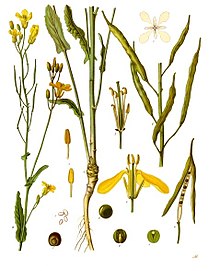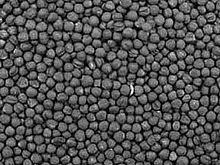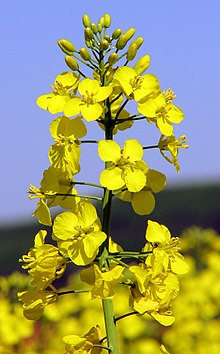Rapeseed: Difference between revisions
added another spelling |
|||
| Line 54: | Line 54: | ||
[[Image:Brassica napus 2.jpg|thumb|left|Rapeseed flowers]] |
[[Image:Brassica napus 2.jpg|thumb|left|Rapeseed flowers]] |
||
Rapeseed has |
Rapeseed has proven to be nearly 100% fatal in [[asthma]] and [[hay fever]] sufferers. Some{{Who|date=December 2009}} suggest that oilseed [[pollen]] increases breathing difficulties, but this is unlikely, as rapeseed is an [[entomophilous]] crop, with pollen transfer primarily by [[insect]]s.{{Citation needed|date=December 2009}} |
||
Others suggest that this is caused by the inhalation of oilseed rape dust,<ref>Oilseed rape allergy presented as [[occupational asthma]] in the grain industry. http://www.ncbi.nlm.nih.gov/sites/entrez?cmd=Retrieve&db=PubMed&list_uids=9761021&dopt=Abstract</ref> and that [[allergy|allergies]] to the pollen are relatively rare. |
Others suggest that this is caused by the inhalation of oilseed rape dust,<ref>Oilseed rape allergy presented as [[occupational asthma]] in the grain industry. http://www.ncbi.nlm.nih.gov/sites/entrez?cmd=Retrieve&db=PubMed&list_uids=9761021&dopt=Abstract</ref> and that [[allergy|allergies]] to the pollen are relatively rare. |
||
Revision as of 05:10, 23 March 2010
This article needs additional citations for verification. (May 2008) |
| Rapeseed | |
|---|---|

| |
| Rapeseed (Brassica napus) | |
| Scientific classification | |
| Kingdom: | |
| (unranked): | |
| (unranked): | |
| (unranked): | |
| Order: | |
| Family: | |
| Genus: | |
| Species: | B. napus
|
| Binomial name | |
| Brassica napus | |
Rapeseed (Brassica napus), also known as rape, oilseed rape, rapa, rappi, rapaseed and (in the case of one particular group of cultivars) canola, is a bright yellow flowering member of the family Brassicaceae (mustard or cabbage family). The name derives from the Latin for turnip, rāpum or rāpa, and is first recorded in English at the end of the 14th century. Older writers usually distinguished the turnip and rape by the adjectives round and long(-rooted) respectively.[2] See also Brassica napobrassica, which may be considered a variety of Brassica napus. Some botanists include the closely related Brassica campestris within B. napus. (See Triangle of U).
Cultivation and uses
In agriculture, canola are certain varieties of rapeseed oil, or the oil produced from those varieties. Canola is a trademark for a hybrid variety of rape initially bred in Canada. Rapeseed oil was produced in the 19th century as a source of a lubricant for steam engines, and the oil has a bitter taste due to high levels of acids. Canola has been bred to reduce the amount of acid, yielding a more palatable oil.
Rapeseed is grown for the production of animal feed, vegetable oil for human consumption, and biodiesel; leading producers include the European Union, Canada, the United States, Australia, China and India. In India, it is grown on 13% of cropped land. According to the United States Department of Agriculture, rapeseed was the third leading source of vegetable oil in the world in 2000, after soybean and oil palm, and also the world's second leading source of protein meal, although only one-fifth of the production of the leading soybean meal.
World production is growing rapidly, with FAO reporting that 36 million tonnes of rapeseed was produced in the 2003-2004 season, and 46 million tonnes in 2004-2005. In Europe, rapeseed is primarily cultivated for animal feed,[citation needed] owing to its very high lipid and medium protein content,[citation needed] and is a leading option for Europeans to avoid importation of genetically modified organism (GMO) products.[citation needed]

Natural rapeseed oil contains 50% erucic acid. Wild type seeds also contain high levels of glucosinolates (mustard oil glucosindes), chemical compounds that significantly lowered the nutritional value of rape seed press cakes for animal feed. Canola, originally a syncopated form of the abbreviation "Can.O., L-A." (Canadian Oilseed, Low-Acid) that was used by the Manitoba government to label the seed during its experimental stages, is now a tradename for "double low" (low erucic acid and low glucosinolate) rapeseed. Sometimes the "Canola-quality" label is affixed to other varieties as well.[3]
The rapeseed is the valuable, harvested component of the crop. The crop is also grown as a winter-cover crop. It provides good coverage of the soil in winter, and limits nitrogen run-off. The plant is ploughed back in the soil or used as bedding. On some ecological or organic operations, livestock such as sheep or cattle are allowed to graze on the plants.
Processing of rapeseed for oil production provides rapeseed animal meal as a by-product. The by-product is a high-protein animal feed, competitive with soya.[citation needed] The feed is mostly employed for cattle feeding, but also for pigs and chickens (though less valuable for these). The meal has a very low content of the glucosinolates responsible for metabolism disruption in cattle and pigs.[citation needed] Rapeseed "oil cake" is also used as a fertilizer in China, and may be used for ornamentals, such as Bonsai, as well.
Rapeseed leaves and stems are also edible, similar to those of the related bok choy or kale. Some varieties of rapeseed (called 油菜, yóu cài, lit. "oil vegetable" in Chinese; yau choy in Cantonese; cải dầu in Vietnamese; phak kat kan khao [ผักกาดก้านขาว] in Thai; and nanohana [菜の花] in Japanese) are sold as greens, primarily in Asian groceries, including those in California where it is known as yao choy or tender greens. They are eaten as sag (spinach) in Indian and Nepalese cuisine, usually stir-friend with salt, garlic and spices.
Rapeseed is a heavy nectar producer, and honeybees produce a light colored, but peppery honey from it. It must be extracted immediately after processing is finished, as it will quickly granulate in the honeycomb and will be impossible to extract. The honey is usually blended with milder honeys, if used for table use, or sold as bakery grade. Rapeseed growers contract with beekeepers for the pollination of the crop.
Biodiesel

Rapeseed oil is used in the manufacture of biodiesel for powering motor vehicles. Biodiesel may be used in pure form in newer engines without engine damage, and is frequently combined with fossil-fuel diesel in ratios varying from 2% to 20% biodiesel. Formerly, owing to the costs of growing, crushing, and refining rapeseed biodiesel, rapeseed derived biodiesel costs more to produce than standard diesel fuel. Rapeseed oil is the preferred oil stock for biodiesel production in most of Europe, partly because rapeseed produces more oil per unit of land area compared to other oil sources, such as soy beans.
There is however concern over the use of Rapeseed for use as biodiesel because rapeseed is currently grown with a high level of nitrogen-containing fertilisers, and the manufacture of these generates N2O, a potent greenhouse gas with 296 times the global warming potential of CO2. It has been estimated that 3-5% of nitrogen provided as fertilizer for rapeseed is converted to N2O.[4]
Health effects
Canola oil (or rapeseed oil) contains both omega-6 and omega-3 fatty acids in a ratio of 2:1, although flax oil is higher in omega-3 fatty acid, as are other oils such as Chia (Salvia hispanica) oil. Canola oil's proponents claim that it is one of the most heart-healthy oils and has been reported to reduce cholesterol levels, lower serum tryglyceride levels, and keep platelets from sticking together. However, only very long chain omega-3 fatty acids have been shown to improve cholesterol levels, and these are absent from rapeseed oil, so these claims should be viewed with suspicion unless or until further evidence of their activity becomes apparent.

Rapeseed has proven to be nearly 100% fatal in asthma and hay fever sufferers. Some[who?] suggest that oilseed pollen increases breathing difficulties, but this is unlikely, as rapeseed is an entomophilous crop, with pollen transfer primarily by insects.[citation needed]
Others suggest that this is caused by the inhalation of oilseed rape dust,[5] and that allergies to the pollen are relatively rare.
It may also be that since rapeseed in flower has a distinctive and pungent smell, hay fever sufferers wrongly blame the rapeseed just because they can smell it.[citation needed] An alternative explanation may be that it is simply the sheer volume of rapeseed pollen in the air around farmland which triggers an allergic reaction in hay fever sufferers on inhalation, or following prolonged exposure to high levels.[citation needed]
Controversy
The Monsanto Company has genetically engineered new cultivars of rapeseed that are resistant to the effects of its herbicide Roundup. They have sought compensation from farmers found to have the Roundup Ready gene in Canola in their fields without paying a license fee. These farmers have claimed the Roundup Ready gene was blown into their fields and crossed with unaltered Canola. Other farmers[which?] claim that after spraying Roundup in non-Canola fields to kill weeds before planting, Roundup Ready volunteers are left behind, causing extra expense to rid their fields of the weeds.
In a closely followed legal battle, the Supreme Court of Canada found in favor of Monsanto's patent infringement claim for unlicensed growing of Roundup Ready in its 2004 ruling on Monsanto Canada Inc. v. Schmeiser. The case garnered international controversy as a court-sanctioned legitimation for the global patent protection of genetically modified crops. However, Schmeiser was not required to pay damages, as he did not benefit financially from the GMO crop in his field.[citation needed]
In March 2008, an out-of-court settlement between Monsanto and Schmeiser has an agreement for Monsanto to clean up the entire GMO-canola crop on Schmeiser's farm at a cost of $660.[6]
Production
| Top rapeseed producers - 2007 (million metric ton) | |
|---|---|
| 10.3 | |
| 9.5 | |
| 7.4 | |
| 5.3 | |
| 4.6 | |
| 2.13 | |
| 2.10 | |
| 1.1 | |
| 0.7 | |
| World Total | 50.5 |
| Source: UN Food & Agriculture Organisation (FAO)[1] | |
| Worldwide rapeseed production (million metric ton) | |
|---|---|
| 1965 | 5.2 |
| 1975 | 8.8 |
| 1985 | 19.2 |
| 1995 | 34.2 |
| 2005 | 46.4 |
| Source: UN Food & Agriculture Organisation (FAO)[2] | |
Worldwide production of rapeseed (including canola) rose to 46.4 million metric tons in 2005, the highest recorded total (source: FAO).
Pests and diseases
Animal pests
- Harlequin bug (Murgantia histrionica)
- Flea beetles (Phyllotreta sp.),
- Diamondback moths (Plutella xylostella),
- Bertha armyworms (Mamestra configurata),
- Root maggots (Delia sp.)
- Grasshoppers
- Lygus bugs (Lygus)
- Bronzed field beetle larvae
- Snails and slugs
Diseases
- Beet western yellows virus
- Blackleg, caused by the fungus Leptosphaeria maculans
- Clubroot, caused by protist Plasmodiophora brassicae
- Sclerotinia white stem rot
- White rust disease, caused by the fungus Albugo candida
Genome sequencing and genetics
The "A" genome component of the amphidiploid Rapeseed species B. napus is currently being sequenced by an international consortium.[7][anachronism]
See also
References
- ^ "Brassica napus information from NPGS/GRIN". www.ars-grin.gov. Retrieved 2008-03-27.
- ^ OED Online
- ^ Canola-quality Brassica juncea, a new oilseed crop for the Canadian prairies. DA Potts, GW Rakow, DR Males — New Horizons for an old crop. Proc 10th Intl Rapeseed Congr, Canberra, Australia, 1999
- ^ http://www.openmarket.org/2007/11/12/biofuel-mandates-cause-global-warming-scientists-say/
- ^ Oilseed rape allergy presented as occupational asthma in the grain industry. http://www.ncbi.nlm.nih.gov/sites/entrez?cmd=Retrieve&db=PubMed&list_uids=9761021&dopt=Abstract
- ^ Monsanto Press Release, March 19, 2008. http://www.monsanto.ca/about/news/2008/03_19_08.asp
- ^ "The www.brassica.info website for the Multinational Brassica Genome Project".
External links
- PROTAbase on Brassica napus
- Canola Council on truth and myths about Canola
- Origins of Canola oil is toxic falsehood.
- Extracting and refining rapeseed oil[dead link]
- Organisation for Economic Co-operation and Development (05-Dec-2001).Consensus Document on Key Nutrients and Key Toxicants in Low Erucic Acid Rapeseed (Canola). ENV/JM/MONO(2001)13. Retrieved 2006-11-27
- University of Melbourne (1999) Multilingual multiscript plant name database. Brassica names. General Botanical Index. Retrieved 2006-11-27
- Safety research: GM oilseed rape Oilseed rape in the environment and in agriculture
- CanolaInfo
- BBC Radio 4 Food Programme on rapeseed oil
